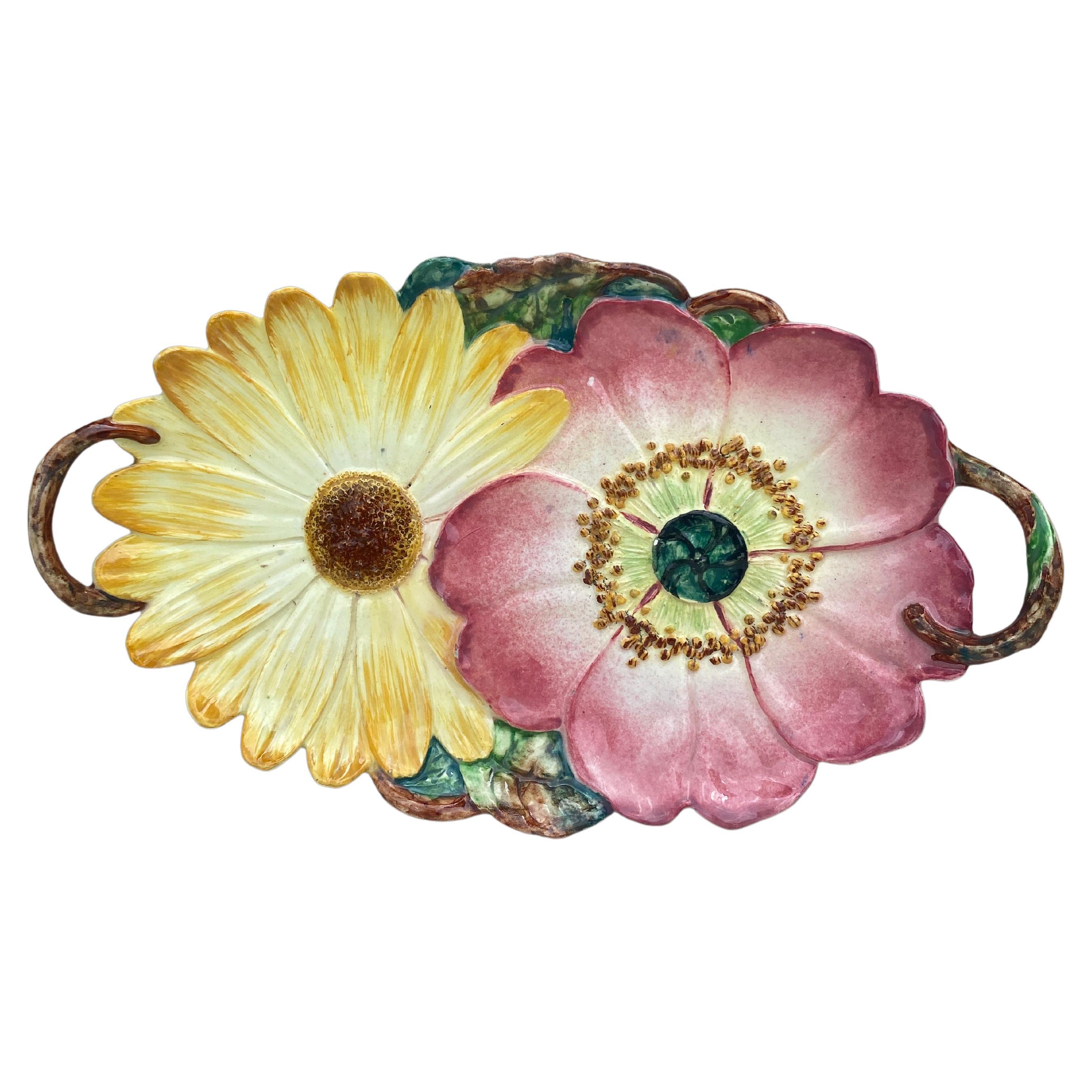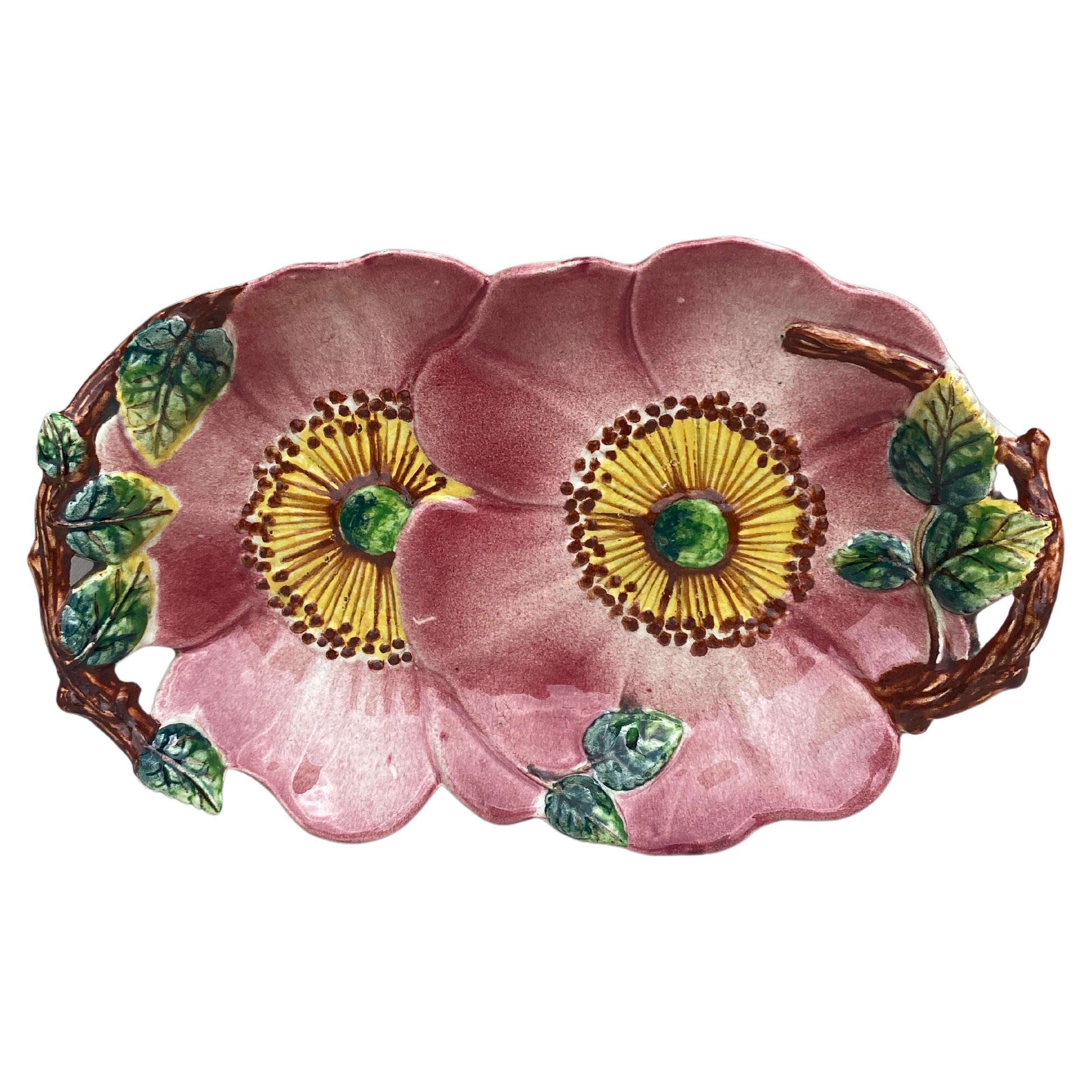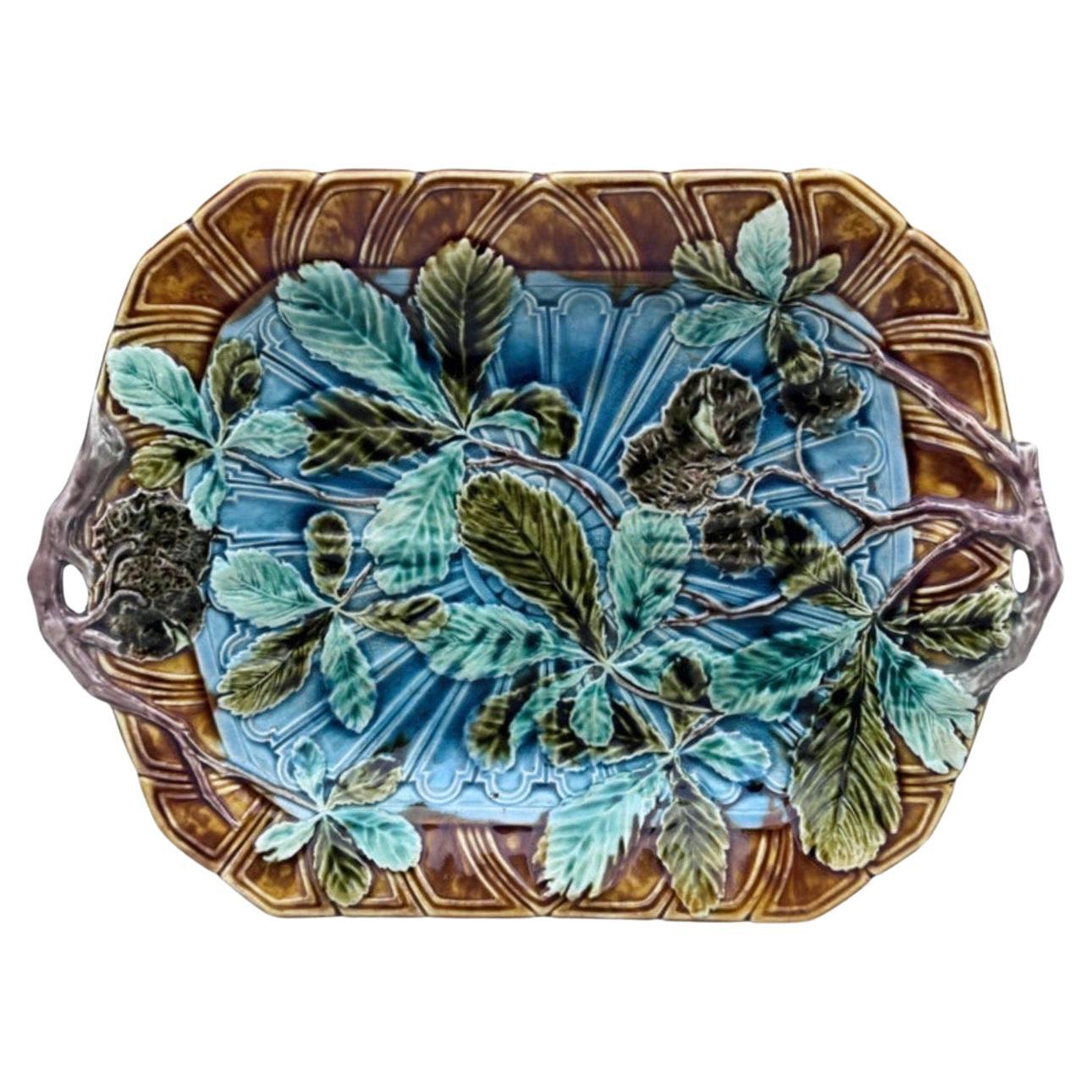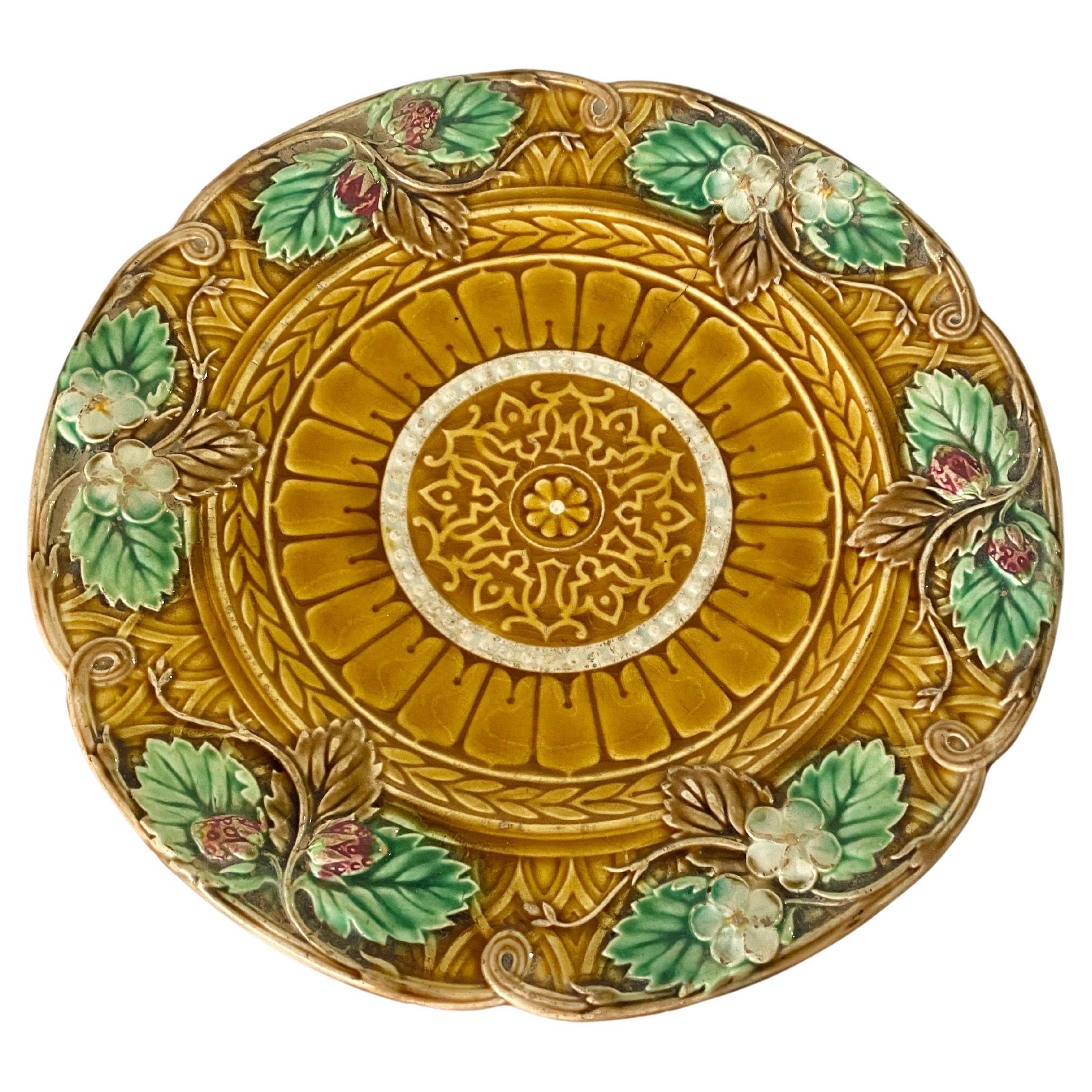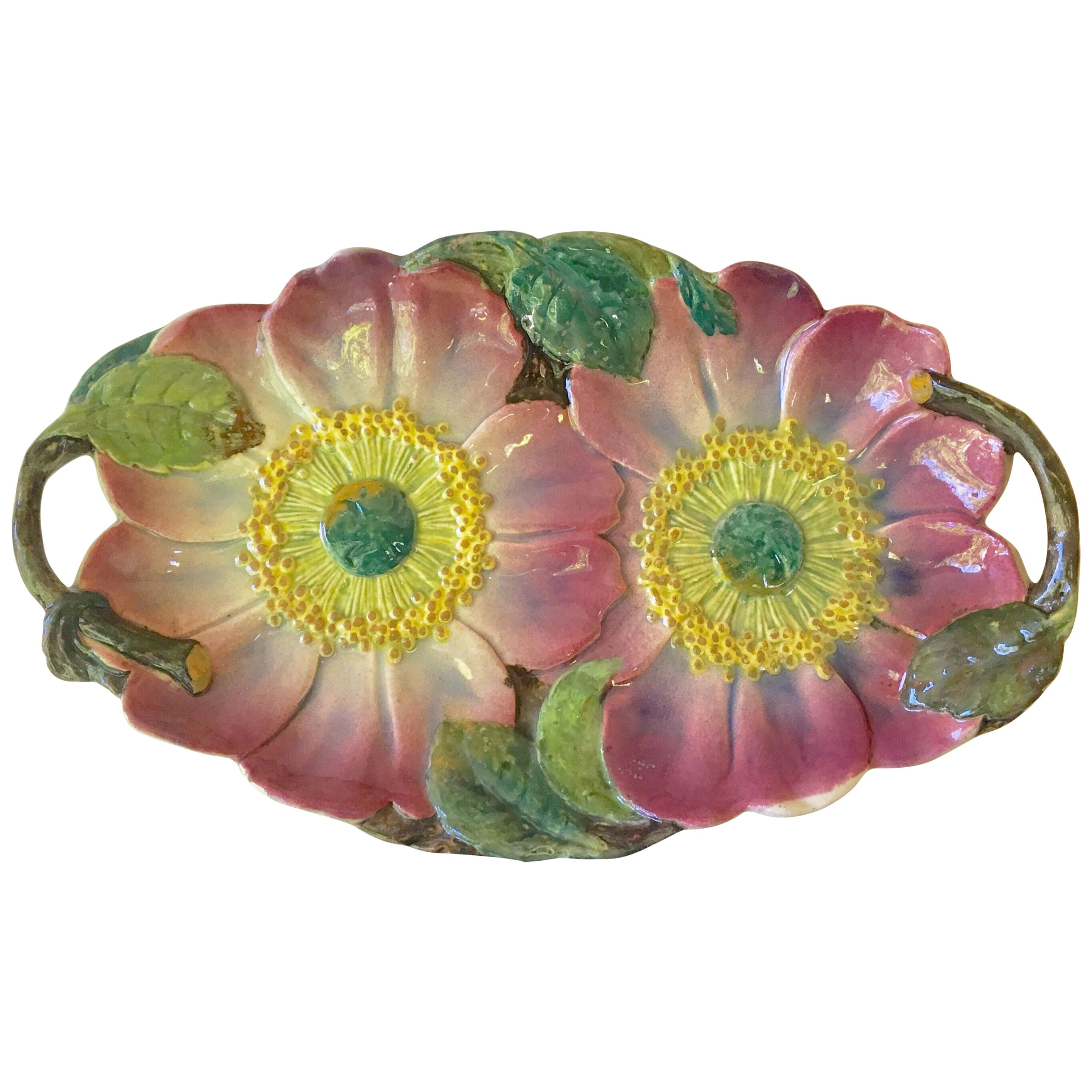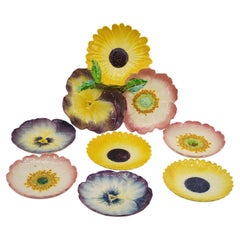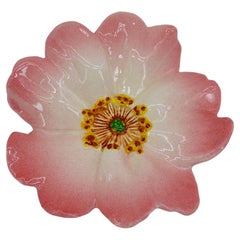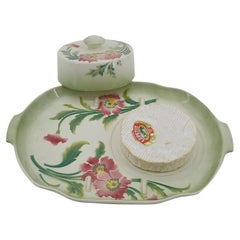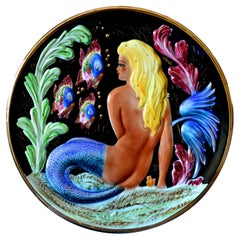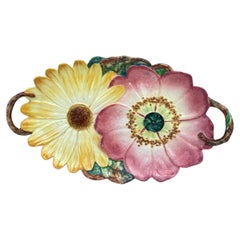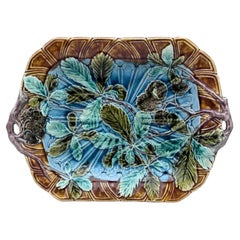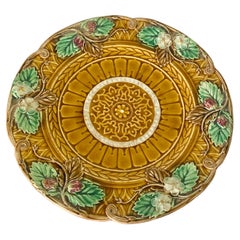Items Similar to Jerome Massier Fils, Majolica Platter, Vallauris, End 19th C.
Want more images or videos?
Request additional images or videos from the seller
1 of 10
Jerome Massier Fils, Majolica Platter, Vallauris, End 19th C.
$2,000
£1,487.66
€1,741.76
CA$2,790.68
A$3,122.85
CHF 1,630.60
MX$38,392.17
NOK 20,571.96
SEK 19,358.11
DKK 12,994.85
Shipping
Retrieving quote...The 1stDibs Promise:
Authenticity Guarantee,
Money-Back Guarantee,
24-Hour Cancellation
About the Item
French Napoleon III majolica slip aperitive or dessert set by Jerome MASSIER, Vallauris, France, end of 19th century. 6 (2x3) plates : anemone, pansy and daisy - Diameter : 7.5"(19cm). 1 platter with the three same flowers - Height : 3"(7.5cm), Diameter : 13"(33cm). Platter and plates (except one) are intaglio stamped. "J.Massier Vallauris" (platter), "Jerome Massier Vallauris" (4 plates) "Jerome Massier Fils Vallauris AM" (1 plate). Excellent original condition (an original crack in the firing on a plate, see last photo).
The Massiers’ work represents a link between traditional Victorian majolica and Art Nouveau pottery. There were three Massiers working in the second half of the nineteenth century, heirs to an old line of potters, who transformed traditional utilitarian ceramics into an art form. Their ancestors had worked for several centuries in Vallauris on the French Riviera, where, in the twentieth century, Pablo Picasso was reigning ceramic artist. Delphin Massier (1836 - 1907), and Clément (1845 -1917) were brothers. A cousin, Jérome (1850 – 1916) worked with them, using the signature « Jérome Massier fils ». By 1899 the family firm was divided into branches headed by these three men.
In 1860 the Massiers began to produce their vibrantly colored majolica, perhaps inspired by the flowers of the Cote d’Azur. Clément was particularly interested in designs drawn from ancient Egypt, Greece, and Rome, as well as from Renaissance maiolica. Themes from these earlier cultures appeared in his highly decorative, large pieces, including vases, ewers, and free-standing decorative columns entwined with flowers. Delphin specialized in freestanding figures of birds, animals, and shellfish – including swans, chickens, sparrows, goats, donkeys, frogs, and crabs – ranging from six to thirty-six inches high. Especially popular were his large roosters, representing the symbol of France. Cockerels and hens, thirty-six inches tall, similar to those of Minton, were extemely well modeled. As with Minton majolica, tree trunks and branches were important in Massier designs. The firm also made majolica candlesticks, vases and cachepots. An unusual pair of majolica tambourines, made by Delphin Massier about 1870, depicts an Arab and his veiled wife.
From 1860 to 1900 skilled painters and sculptors who worked with the Massiers included Jean Barerol, Jean Bagnis, Camos, the Scotsman Alexander Munrose, the Swiss sculptor James Reibert, and greatest of all, Lucien Lévy. The latter was a passionate admirer of sinuous and sensuous floral arabesque patterns and his influence was felt in the Massiers’ designs. Lévy worked with Clément Massier from 1887 to 1895 before devoting himself exclusively to painting. In Paris, under the name of Lévy-Dhurmer, he became one of the leaders of Art Nouveau. The Massiers used in a particularly dramatic way the copper oxide flambé technique for glazing, a method that originated in China during the Sung dynasty (960 – 1280), in which the kiln is rich in carbon dioxide and low in oxygen (reduction atmosphere). The flambé technique as practiced by the Massiers also incorporated the lustre technique of the Hispano-Moresque ceramics. It entailed covering a previously glazed piece with a metallic silver or copper oxide and firing it again at a very low temperature "petit feu". The resulting new palette, intense rather than subtle, included colors hitherto unknown to majolica : powdered gold, speckled turquoise, willow-green, yellow-orange, hot pink, purple-violet, and peacock blue, as well as flambé and solid reds.
At the close of the nineteenth century the Massiers achieved a considerable reputation for their brilliantly glazed majolica and the factory enjoyed great success at national and international exhibitions. The arrival of the railroad in Vallauris increased their renown throughout France and the world of ceramics in general. A visit to the Massier workshop became mandatory for the cultured visitor to the French Riviera. Queen Victoria, King of Sweden, the Prince of Wales, Emile Zola, Victor Hugo, Camille Saint-Saëns, Charles Gounod, Georges Sand, Frédéric Mistral all visited and made purchases. They bought rectangular planters on which perched flocks of birds, plates and platters made of huge flower petals, wall plaques in the shape of butterflies, magnificent pitchers, and charming majolica-framed clocks.
Early Massier works rarely bore a signature. From 1862 to about 1902 (when the factory closed), with the firm’s increasing success, the signatures of each of the Massiers appeared on their pieces. They are represented in the Musée Municipal de Céramique et d’Art Moderne in Vallauris and two Paris museums : the Musée d’Art Moderne de la Ville de Paris and the Musée d’Orsay.
Each Massier was competent in the production of majolica glazes : all three shared a preference for green, red, and blue, especially the peacock blue that had been created by Delphin and Clément’s mother, Elisabeth. That inventive woman obtained the necessary copper oxide by scraping it from the sides of the stills used for the distillation of flowers by the manufacturers of perfumes in Grasse, a few kilometers from Vallauris. The Massiers were also indebted to a ceramist from Bologna, Gandolfo Gaetano, who had lived in Vallauris since the mid-century. Gaetano guided Clément Massier in the discovery of the splendors of the old ceramics, including the Hispano-Moresque techniques.The French potter Jacques Sicard worked closely with Clément Massier and acquired a great knowledge of fridescent glazes during that long association. In the early twentieth century he was employed at Samuel A. Weller’s pottery in Ohio, where Sicard’s technical skills enabled him to create a line of lustrous art pottery called Sicardo ware. He returned to France in 1907.
- Creator:Delphin Massier (Artist)
- Dimensions:Height: 2.96 in (7.5 cm)Diameter: 13 in (33 cm)
- Style:Napoleon III (Of the Period)
- Materials and Techniques:
- Place of Origin:
- Period:
- Date of Manufacture:End of 19th century
- Condition:
- Seller Location:Saint-Amans-des-Cots, FR
- Reference Number:1stDibs: LU2312341004652
About the Seller
5.0
Platinum Seller
Premium sellers with a 4.7+ rating and 24-hour response times
Established in 2003
1stDibs seller since 2016
483 sales on 1stDibs
Typical response time: 1 hour
- ShippingRetrieving quote...Shipping from: Saint-Amans-des-Cots, France
- Return Policy
Authenticity Guarantee
In the unlikely event there’s an issue with an item’s authenticity, contact us within 1 year for a full refund. DetailsMoney-Back Guarantee
If your item is not as described, is damaged in transit, or does not arrive, contact us within 7 days for a full refund. Details24-Hour Cancellation
You have a 24-hour grace period in which to reconsider your purchase, with no questions asked.Vetted Professional Sellers
Our world-class sellers must adhere to strict standards for service and quality, maintaining the integrity of our listings.Price-Match Guarantee
If you find that a seller listed the same item for a lower price elsewhere, we’ll match it.Trusted Global Delivery
Our best-in-class carrier network provides specialized shipping options worldwide, including custom delivery.More From This Seller
View AllJerome Massier, Majolica Aperitive or Dessert Set, Vallauris, End 19th C.
By Jerome Massier
Located in Saint-Amans-des-Cots, FR
French Napoleon III Majolica Slip Aperitif or Dessert Set by Jérôme Massier, Vallauris, France, Late 19th Century.
This exquisite Napoleon III majolica slip aperitif or dessert set,...
Category
Antique Late 19th Century French Napoleon III Platters and Serveware
Materials
Earthenware
Delphin Massier Flower Wall Stand, Vallauris, Late 19th Century
By Delphin Massier
Located in Saint-Amans-des-Cots, FR
Flower wall stand by Delphin Massier, Vallauris, France, late 19th century. Earthenware. This line of Delphin Massier products is illustrated in 'Massier, L'introduction de la cérami...
Category
Antique Late 19th Century French Art Nouveau Pottery
Materials
Ceramic
Saint-Clement French Art Nouveau Ceramic Cheese Dish
By Saint-Clément
Located in Saint-Amans-des-Cots, FR
Rare cheese dish by Saint-Clement, France, late 19th-Early 20th Century, featuring a charming poppy design. This exquisite piece is a true collector’s item, as dishes of this period ...
Category
Antique Early 1900s French Art Nouveau Ceramics
Materials
Ceramic
Kerina, Monaco, Majolica Wall Platter Vallauris, 1960s
Located in Saint-Amans-des-Cots, FR
Majolica wall platter by Kerina, Monaco, ca.1960. Measure: diameter: 13.2" (33.6cm), depth: 1.8"(4.5cm). Signed "Kérina Monaco" on the back. Few slight traces of age. Very good condi...
Category
Vintage 1960s Monacan Mid-Century Modern Decorative Art
Materials
Ceramic, Majolica
Salins-lès-Bains Rare French Art Majolica Ceramic Asparagus Set, Late 19th C.
By Salins
Located in Saint-Amans-des-Cots, FR
French Art Majolica Ceramic Asparagus Set by Salins-lès-Bains, France, Late 19th Century.
This exquisite and rare French art majolica asparagus set, crafted by Salins-lès-Bains in t...
Category
Antique Late 19th Century French Napoleon III Tableware
Materials
Ceramic, Majolica
Longwy Mid-Century Enameled Ceramic Wall Platter, Limited Edition, 1950s
By Faïenceries et Emaux de Longwy
Located in Saint-Amans-des-Cots, FR
This exceptional mid-century French glazed ceramic wall dish is a captivating piece from the Manufacture de Longwy, made in the 1950s. It is part of a limited edition, with only 18 o...
Category
Vintage 1950s French Mid-Century Modern Platters and Serveware
Materials
Ceramic
You May Also Like
19th Century Majolica Flowers Handled Platter Massier
By Delphin Massier
Located in Austin, TX
Antique Majolica handled platter with a wild rose and a yellow daisy unsigned Massier, circa 1890.
Category
Antique 1890s French Art Nouveau Platters and Serveware
Materials
Majolica, Ceramic
French Majolica Wild Rose Platter, circa 1900
Located in Austin, TX
Charming Art Nouveau Majolica handled platter with two pink wild roses inspired by Delphin Massier, circa 1900.
Category
Antique Early 1900s French Art Nouveau Platters and Serveware
Materials
Majolica, Ceramic
French Majolica Chesnut Platter Sarreguemines, circa 1870
By Sarreguemines
Located in Austin, TX
Rare French Majolica Chesnut Platter signed Sarreguemines Majolica circa 1870.
Category
Antique 1870s French Victorian Platters and Serveware
Materials
Ceramic, Majolica
Majolica Plate by Sarreguemines, Faience 19th Century, France
Located in Auribeau sur Siagne, FR
This Plate is a Majolica plate made in the Sarreguemines Manufacture. This glazed Faience, is in yellow and green color. It has been done in the 19th century.
Category
Antique 19th Century French French Provincial Delft and Faience
Materials
Faience
$258 Sale Price
20% Off
Majolica Wild Rose Platter Massier Jerome Massier Fils, circa 1900
By Jerome Massier Fils
Located in Austin, TX
Charming Art Nouveau Majolica handled platter with two pink wild roses signed Jerome Massier Fils, circa 1900.
Category
Antique Early 1900s French Art Nouveau Platters and Serveware
Materials
Majolica
19th Century English Majolica Geranium Platter
Located in Austin, TX
19th Century English Majolica Geranium platter.
Category
Antique 1890s English Victorian Platters and Serveware
Materials
Ceramic
